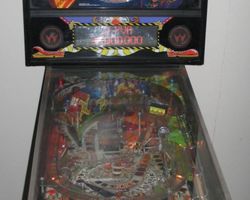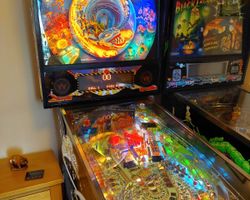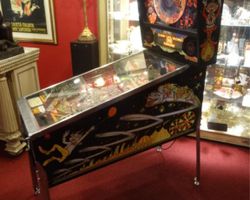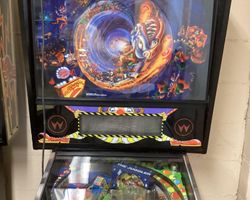Hurricane

Average Prices: USD $600 to $2,000
Produced: August, 1991
Machine Type: Solid State Electronic
MPU: Williams WPC (Dot Matrix)
Players: 4
Design by: Barry Oursler
Art by: John Youssi
Mechanics by: Gerald Hedberg
Music by: Paul Heitsch
Sound by: Paul Heitsch
Software by: Mark Penacho
Williams Electronic Games, Inc. introduced "Hurricane" in August 1991, a solid-state electronic pinball machine that immersed players in a vibrant amusement park setting. This machine represented the culmination of a thematic trilogy by designer Barry Oursler, following "Comet" (1985) and "Cyclone" (1988), each drawing inspiration from the exhilarating world of roller coasters and carnivals. "Hurricane" expanded on its predecessors' foundational concepts, integrating advancements in pinball technology while retaining the playful spirit that defined Oursler’s earlier works.
The design and production of "Hurricane" involved a collaborative effort from various talented individuals within Williams. Barry Oursler conceptualized the game's flow and layout, ensuring a blend of approachable shots and engaging mechanics. The visual identity of the machine was crafted by a team of artists, with John Youssi contributing to the distinctive backglass artwork, and Python Anghelo leaving his mark on the playfield design, with both artists’ signatures present on the finished product. Kevin O'Connor also contributed to the artistic vision. On the auditory front, Paul Heitsch composed the music and sound effects, creating an atmospheric backdrop that enhanced the carnival theme. The complex software logic that brought the playfield to life was developed by Mark Penacho, while Gerald Hedberg engineered the mechanical intricacies. Tony Goskie and Tim Coman handled the dot-matrix display (DMD) animations, bringing characters and events to life with pixels. Released on August 8th, 1991, "Hurricane" was part of the Williams WPC (Dot Matrix) generation of machines, signifying a shift towards more dynamic visual displays. A total of 4,400 units were produced, making it a moderately sized production run for its era. The machine carried the model number 50012 and featured a manual plunger.
Signature Features and Design
"Hurricane" distinguishes itself with several unique playfield mechanisms and visual elements that deepen its amusement park theme. Central to its identity are the two rotating Ferris wheels positioned on the main playfield. These mechanisms briefly carry the pinball for a portion of their rotation, an idea that had appeared previously on Williams' "Cyclone" and even earlier on Allied Amusement's "Barrel Roll" from 1935. This feature not only adds visual interest but also momentarily alters the pace of play. Another notable inclusion is "The Juggler," a ball popper arch that serves as a shot target, holding the ball briefly before kicking it back into play.
The machine's backbox also features a mechanical animation: a large disc that spins, reminiscent of a "Mystery Wheel," an element that evolved from the backglass concept seen in "Cyclone." This physical spinner in the backbox complements the DMD animations, providing a tangible, moving spectacle beyond the main playfield. An oval topper mirroring the translite's circular motif further enhances the visual cohesion, featuring lit graphics and flashers that contribute to the overall carnival ambiance. The "Dunk the Dummy" target adds a specific objective and character interaction, providing direct feedback and points for hitting the target. These distinct features—the Ferris wheels, The Juggler, the spinning backbox disc, and the "Dunk the Dummy" target—work in concert to create an immersive and playful atmosphere, truly embodying the spirit of a carnival and setting "Hurricane" apart.
Playfield and Mechanics
The "Hurricane" playfield is designed to evoke the bustling environment of an amusement park, featuring a layout that prioritizes flow and a sense of progression through various attractions. The primary shots include two ramps, which are a defining characteristic of Barry Oursler's designs from this period. The "Hurricane Ramp" itself is a prominent looping ramp, offering a satisfying shot. Three pop bumpers located near the top of the playfield provide chaotic action and contribute to score accumulation. Four standup targets and a three-bank drop target setup offer distinct objectives for players to aim for. The interactive Ferris wheels, positioned strategically, briefly suspend the ball, altering the rhythm of gameplay and providing unique visual moments. The "Juggler" mechanism acts as a ball-capturing and launching device, creating a distinct playfield event when activated. The "Dunk the Dummy" target, usually positioned towards the center-right, encourages direct and deliberate shots.
The design philosophy behind the "Hurricane" playfield emphasizes accessible and repeatable shots, making the game approachable for various skill levels. The two ramps serve as key shot multipliers and progression paths. While the looping Hurricane ramp can be satisfying, the mechanics of the double Ferris wheels, while visually engaging, can momentarily slow the game's pace as the ball is carried around. This balance of fast ramp shots and slower, more deliberate toy interactions contributes to "Hurricane"'s distinct play style. Aesthetically, the playfield is adorned with vibrant artwork by John Youssi and Python Anghelo, depicting a lively carnival scene filled with attractions, clowns, and bright colors. The lighting scheme enhances this atmosphere, illuminating targets and features to guide the player's eye. Despite its colorful and energetic design, some aspects of the original cabinet artwork are prone to fading over time, and some plastics on the playfield can be susceptible to breakage, which are common considerations for older machines.
Gameplay Dynamics
"Hurricane" offers engaging gameplay dynamics centered around an accessible rule set and a focus on hitting various carnival attractions. The game features a 3-ball multiball, a staple of pinball design that amplifies scoring opportunities and excitement. Progression often involves hitting specific shots to light modes or advance towards multiball. For instance, successfully shooting the ramps, hitting the drop targets, or interacting with the "Juggler" all contribute to overall score and game advancement. The "Dunk the Dummy" feature provides a direct objective, rewarding players for hitting the target to send the dummy plunging.
The scoring system encourages players to string together shots and activate features. The Hurricane ramp, in particular, can become a significant source of points, especially during multiball phases, which some players note can lead to a slight imbalance where this shot becomes disproportionately valuable. Unique objectives within "Hurricane" are less about complex, branching modes and more about the immediate satisfaction of completing carnival tasks. For example, lighting and successfully shooting specific targets around the playfield may build towards bonus multipliers or special awards. The custom speech, featuring callouts from various carnival characters and the "Dunk the Dummy" taunts, adds character and encouragement, though some players have found the repetition of these sounds to become grating over extended play. Player strategies often involve mastering the looping Hurricane ramp shot to initiate and prolong multiball, while also strategically aiming for the Ferris wheels for their unique ball-carrying action and the "Juggler" for its captive ball interaction. The relatively straightforward rules make "Hurricane" approachable for new players, allowing them to grasp the objectives quickly and enjoy the thrill of the carnival without deep rule memorization.
Reception and Legacy
"Hurricane" elicits a range of opinions within the pinball community, often characterized by its strengths as a fun, approachable game alongside critiques regarding its depth. On the positive side, many players find "Hurricane" to be an enjoyable experience, particularly for casual play and as a family-friendly machine. Its amusement park theme is widely appreciated for its ability to create an immersive atmosphere through coordinated sounds, music, and artwork. The machine's unique features—such as the double Ferris wheels, The Juggler, the looping Hurricane ramp, and the "Dunk the Dummy" target—are frequently highlighted as standout elements that contribute to its distinctive character. The spinning backbox animation and the lively DMD animations also receive praise for their visual appeal. For its accessible price point relative to many other titles, "Hurricane" is often seen as a good value proposition, making it an attractive entry point for new collectors or those seeking a playful addition to their collection. Its straightforward nature makes it particularly suitable for beginners and intermediate players.
However, "Hurricane" also faces criticisms, primarily concerning its gameplay depth and flow. Some experienced players describe the rules and objectives as simple, leading to a sense of shallow engagement over time. The reliance on the Hurricane ramp shot, especially during multiball, can lead to repetitive gameplay for those seeking more varied strategic opportunities. The inclusion of the double Ferris wheels, while visually distinct, can slow the game's pace, a characteristic that some players find disruptive to the flow. Similarly, the repetitive nature of certain callouts, particularly from the dummy, and specific sound effects can become tiresome during extended play sessions. Aesthetic preferences also play a role, with some players finding the artwork to be overly busy or "clownish." Additionally, the propensity for the original cabinet art to fade and for certain plastic components to become brittle over time are practical considerations.
Despite these mixed views, "Hurricane" generally maintains a positive reputation, especially among players who value pure fun over complex rule sets. It stands as a notable part of Barry Oursler's carnival trilogy, with its standing relative to "Comet" and "Cyclone" being a subject of ongoing discussion among enthusiasts. Its significance lies in its successful execution of a beloved theme, incorporating creative mechanical features that provide a memorable pinball experience, particularly for those seeking a lighthearted and engaging game.
Sponsored Links
 Ebay Listings
Ebay Listings
 Auction Results
Auction Results
| Cost | Location | Date |
|---|---|---|
| GBP £4,587 |  Rushden, United Kingdom Rushden, United Kingdom |
01 September, 2025 |
| USD $2,500 |  Massachusetts, United States Massachusetts, United States |
03 August, 2025 |
| GBP £3,000 |  Minehead, United Kingdom Minehead, United Kingdom |
08 December, 2024 |
| GBP £1,909 |  United Kingdom United Kingdom |
18 October, 2024 |
| USD $4,000 |  California, United States California, United States |
13 October, 2024 |
| GBP £2,350 |  United Kingdom United Kingdom |
24 July, 2024 |
| GBP £2,850 |  United Kingdom United Kingdom |
25 March, 2024 |
| USD $1,600 |  California, United States California, United States |
18 February, 2024 |
| USD $2,100 |  Maryland, United States Maryland, United States |
09 November, 2023 |
| EUR €2,250 |  Bayern, Germany Bayern, Germany |
26 October, 2023 |


Private Policy · Search Website · Contact Us
As an eBay Partner, we may earn a commission from qualifying purchases made through links on this site, at no additional cost to you.
All trademarks and copyrighted materials remain property of their respective owners. All other content copyright 2007 - 2025 Pinpedia.







